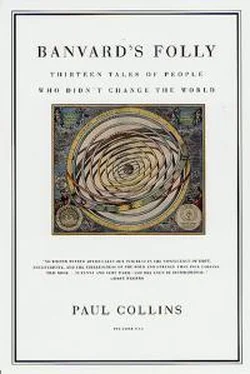There is also a novel that used the Ireland scandal--The Talk of the Town (1885) by James Payn. It's rare, and the only copy I've come across is at the New York Public Library.
JOHN CLEVES SYMMES
For sheer novelty value, it's hard to beat the anonymously written (and incorrectly attributed to Symmes) 1820 novel Symzonia: Voyage of Discovery, by
"Capt. Adam Seaborn." The Arno Press put out a facsimilie volume in 1974, though even that is hard to find now.
The two best explanations of Symmes's theories are The Symmes Theory of Concentric Spheres (1878) by Americus Symmes, which can be purchased in microfilm for one (1) arm and one (1) leg from the British Library; and James McBride's Symmes's Theory of Concentric Spheres (1826), available at the New York Public Library. Thomas Matthews's critical Lecture on Symmes's Theory (1824) and Jeremiah Reynolds's Remarks on a Review of Symmes' Theory (1827) are both in the Beinecke Library at Yale University. A microfilm of Symmes's original 1818 broadside can also be found at Columbia University.
One of the best posthumous accounts of Symmes is in the October 1882 issue of Harper's New Monthly, pp. 740-44; many later accounts simply rehash this article. Victoria Nelson's self-indulgent, though erudite, account of hollow
earth theories through the ages can be found in the Fall 1997 issue of Raritan, pp. 136-66. There is an excellent chapter on Reynolds and Symmes in William Stanton's 1975 book The Great United States Exploring Expedition of 1838-1842, and Martin Gardner gives an entertaining account of later hollow earth quacks in his 1957 classic Fads and Fallacies in the Name of Science.
For examples of the motions made in Congress on behalf of Symmes, see The Debates and Proceedings in the Congress of the United States (later titled Register of Debates in Congress) for March 7, 1822 (senate Proceedings), February 3, 1823 (house Proceedings), February 7, 1823 (senate Proceedings), and February 10, 1823 (house Proceedings).
RENÈ BLONDLOT
The first place to go is Blondlot's own book, The n-Rays: A Collection of Papers Communicated to the Academy of Sciences (1905), available at the New York Public Library and the University of California at Berkeley. Watching his argument unfold, complete with diagrams and photos of n-ray phenomena, you start to understand how this man could have become so convinced of his own theory. Other contemporary descriptions can be found in Henri Bordier's Les Rayons n et les Rayons n1 (1905) and Alphonse Berget's Le Radium at Les Nouvelles Radiations (rayons X et Rayons n) (1904); UC Berkeley possesses copies. For an account from the medical side, see Dr. Margaret Cleaves's 1904
book Light Energy; I was able to find a copy at UC San Francisco. One example of how n-ray hoopla came to the general public is in Edward Romilly's "Human Radiations. n-Rays. Facts and Queries" (1904), a curious booklet in the collection of the British Library. Their copy still has the two little glass screens helpfully pasted inside the front cover for readers to perform their own experiments.
Much of n-ray controversy was fought in the pages of science journals, though, because it exploded and then imploded too quickly for many books to be published on the subject. See Nature magazine for 1903: December 24; for 1904: January 21, January 28, February 18, March 3, March 10, March 24, April 7, Sept. 29; for 1905: June 29. Also, see The Lancet, for 1904: February 6, February 20, February 27, March 5, March 12, March 19, March 26, April 9, April 16, April 23, November 12, December 10; for 1905: January 7, January 14.
For Robert Wood's own account of his visit to Blondlot's lab, see the lengthy quotation in William Seabrook's 1941 biography, Doctor Wood. Modern accounts of the scandal can be found in Irving Klotz's "The n-Ray Affair," Scientific American, May 1980; Irving Langmuir's "Pathological Science," Physics Today, October 1989; and Isaac Asimov's Out of the Everywhere (1990).
FRAN@COIS SUDRE
Unless you happen to be within walking distance of the National Library in Paris, it can be difficult to find information on Solresol in the offline world. Fran@cois and Josephine Sudre's masterwork Langue Musicale Universelle (1866) and Aimè Paris's vitriolic La Langue Musicale (1846) and Un Correction
@a M. Sudre (1847) are all at the Library of Congress. Rapports sur la Langue Musicale is in the Music Room at Yale University; you'll often find that Sudre's few surviving works are misfiled in the music sections of libraries.
Pages 31-38 of Louis Couturat and Leopold Leau's Histoire de la Langue Universelle (1907), available at the New York Public Library, contain what amounts to an obituary on Solresol. David Whitwell's very useful if occasionally repetitious history of Sudre, La T@el@ephonie and the Universal Musical Language (1995), is sold as a photocopy directly from Professor Whitwell himself. Call California State University (northridge) and ask the music department for his extension.
The online world is rapidly growing as a source of Solresoliana; any resources listed here will surely be out of date before this even reaches the press. But for now the sites to look for are Stephen Rice's excellent page, which includes his translation of Boleslas Gagewski's Grammaire du Solresol (
http://www.ptialaska.net/ srice/solresol/intro.htm); Jason Hutchens's page (
http://www.amristar.com.au/ ~hutch), and Greg Baker's page (
http://www.ics.mq.edu.au/ ~gregb/solresol/index.html).
Curiously, the notion of music conveying emotional content or generalized messages achieved brief artistic vogues among composers. In 1881, J. A.
Goodrich published a slim volume titled Music as a Language, which attempted without much success to show how specific emotions and ideas were conveyed by certain chord intervals and counterpoints. Over a century later, Professor Joseph Swain attempted the same feat with his 1997 book Musical Languages, with about the same lack of convincing results. No one seems to have advanced much beyond the oboe section saying "Ha ha ha ha ha."
EPHRAIM BULL
Ephraim Bull's papers are at the Concord Free Public Library, and the librarians there are tremendously helpful. Foremost among the horticulture books of Bull's era are The American Grape Growers Guide (1852), by William Chorlton, and Andrew Fuller's The Grape Culturist (1864), both of which went through many editions. Also see J. Fisk Allen's Practical Treatise on the Culture and Treatment of the Grape Vine (1859) and Robert Buchanan's Culture of the Grape, and Wine-Making (1852). Coming later are Viala and Ravaz's American Vines (resistant Stock) (1903) and George Hussman's American Grape Growing and Wine Making (1915). These books are widely available at research libraries and through antiquarian booksellers.
There are numerous accounts of old Concord, including Townsend Scudder's Concord: American Town (1947), Allen French's Old Concord (1919), and Josephine Swayne's The Story of Concord (1939), and in Franklin Sanborn's memoirs Sixty Years of Concord 1855-1915, edited and published by Kenneth Cameron in 1976. Brief mentions of Bull may be found in editions of Hawthorne's letters, as well as in two biographies by Julian Hawthorne: Hawthorne and His Circle (1903) and Hawthorne and His Wife (1885).
Sir Henry Bessemer's life is chronicled in his Autobiography (1905), which can be had for a high price from antiquarian dealers; those with an engineer's cast of mind will find themselves in good company as they read Bessmer's narrative. The history of Dr. Welch can be sought out in William Chazanof's Welch's Grape Juice: From Corporation to Co-operative (1979). An odd sidelight of its history crops up in the company's own 1921 volume Grape Juice as a Therapeutic Agent, which is carried by a surprising number of antiquarian dealers, but is equally difficult to find in most libraries.
Читать дальше











